
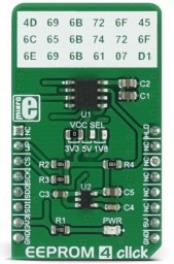
|
EEPROM 4 click Released

EEPROM 4 click is 2,097,152 bits on a click board™, organized into 262,144 bytes. In other words, this click board™ is an EEPROM memory medium with the capacity of 256 KB. The used EEPROM module has very good endurance and it can withstand 1,000,000 write cycles, with the data retaining period of about 40 years. The EEPROM module on this click can work with power supply voltage ranging from 1.7V to 5.5V, it features the self-timed write cycles, doesn't require erase before writing, has a dedicated write protect pin for hardware protection of stored data, and has a dedicated hold pin used for holding the data transfer.
EEPROM 4 click is aimed towards industrial and commercial applications, which require low voltage and low power operational capabilities. It can be used for any kind of temporary or permanent data storage for various embedded electronic devices, simple data logging, storing various working parameters of a module or device, safeguarding the sensitive data in case of a power cycle, and other similar applications where EEPROM memory is needed. |
2018/01/19 |

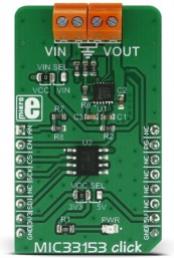
|
MIC33153 click Released

MIC33153 click is a DC-DC adjustable step-down (buck) converter that is designed to deliver a substantial amount of current to very demanding loads, with the voltage output up to 3.5V. The ultra-fast transient response and the ripple free output voltage are some of the main features of this DC-DC step-down converter. The proprietary HyperLight Load™ technology allows very efficient step-down conversion even for very light loads.
This adjustable DC-DC step-down converter click board™ has a very specific field of applications in which it gives the best results. Due to its ripple free voltage output and very high conversion efficiency, it is designed to be used as the power supply for the various portable GPS devices, mobile handsets, portable media and mp3 players, wireless LAN cards and similar applications that demand very clean power supply and high step down DC-DC conversion efficiency factor. |
2018/01/19 |

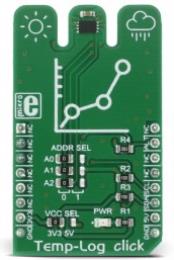
|
Temp-Log click Released

Temp-Log click is a precise ambient temperature measurement device, equipped with 8Kbit (1024 bytes) of EEPROM memory, which can be used to permanently store system configuration or log application specific or user preference data. This click covers a range of temperatures from -55°C to +125°C with the highest accuracy of ±0.5°C, in the range of 0°C to 85°C. The device can also send an ALERT signal to the INT pin of the mikroBUS™ every time programmed temperature thresholds are reached.
Besides the EEPROM, the device also contains non-volatile configuration register, which is copied to the main configuration register after every restart of the device. This allows for near-autonomous operation of the device, without the need to initialize the sensor configuration parameters after every power cycle. These features make the Temp-Log click a perfect choice for temperature measurement in a wide variety of communication, consumer, computer, industrial and similar applications, with an addition of up to 8Kbit of user data storage space. |
2018/01/19 |


|
PT100 3-wire temperature probe Released

Platinum resistance temperature sensor
PT100 3-wire temperature probe is a type of RTD platinum probe used to measure temperatures up to 250°C. This type of probe can be used with RTD click.
RTD sensors are basically thermosensitive resistors – materials that change the resistance depending on their temperature. In this case, the resistor is a small strip of platinum with a resistance of 100? at 0°C - that is why it is called PT100.
|
2018/01/19 |

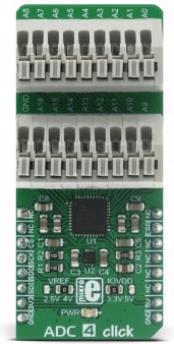
|
ADC 4 click Released

ADC 4 click is an advanced analog to digital multichannel converter, which can sample inputs from 16 single-ended channels or 8 differential input channel pairs. This device has a quite high sampling resolution of 24 bits and the output data rates can range from 5 SPS to 250 kSPS. Besides the internal 2.5V reference voltage source, ADC 4 click is also equipped with an external reference voltage circuit, which provides 4.096V. Finally, a custom reference voltage - up to 5V can be connected to the multiplexed inputs of the ADC converter. These options give a lot of flexibility in choosing the right reference voltage for any application.
Along with the two 9 pole spring action terminals that provide easy and secure connection to the input channels, this device has many other outstanding features, which make it a perfect choice for an accurate and simple digitalisation of analog signals from various sensors in PLC/DCS modules, temperature and pressure measurement, medical and scientific instrumentation, chromatography and other similar applications, where accurate analog to digital conversion is needed. |
2018/01/19 |

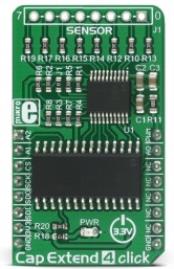
|
Cap Extend 4 click Released

Cap Extend 4 click provides a unique opportunity to control digital devices by using a variety of physical objects. This click adds touch/proximity detection feature to any application, providing an easy and intuitive framework for building a human-machine interface. The click can be connected to eight different sensors, which can sense touch/proximity through a number of various materials, such as wood, plastic or even metal, thanks to Microchip's proprietary Metal over Capacitive technology.
Cap Extend 4 click can be used for building human-machine interfaces for various touch activated applications, such as light switches, toys and office equipment, device activation via the PCB touch buttons, and other innovative and interesting ways of touch control. |
2018/01/19 |

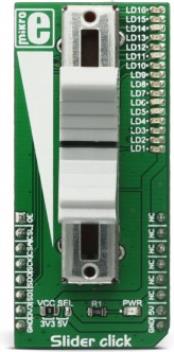
|
Slider click Released

Slider click features a mechanical slide action potentiometer - a slider, which gives a nice feeling when actuating, along with 16 SMD LEDs, that can be used for any kind of visual feedback. The onboard high-resolution 22-bit ADC can detect even the smallest move, faithfully capturing the smoothness of the slider movement, while digitizing its position. The 16 onboard SMD LEDs can give a nice visual feedback of the slider position, but those LEDs can also be used for other purposes since they are not hardwired to the slider.
Slider click can be used to control various digital applications with an accurate and comfortable slider potentiometer, while the LEDs can be used to display the desired information in a form of a bar or a position. For example, Slider click can be used to control a quad digital potentiometer, such as the one that can be found on DIGIPOT 5 click, while displaying the position of the selected digital wiper on the LEDs. |
2018/01/19 |

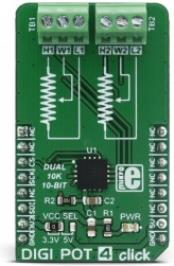
|
DIGI POT 4 click Released

DIGI POT 4 click is a digitally controlled dual potentiometer, with the resistance of 10K?. It has a 10bit resolution which allows for a very smooth linear wiper positioning through 1024 steps. Digital wiper position can be controlled via SPI interface. DIGI POT 4 click also features a non-volatile durable EEPROM memory for storing the wiper position, which means that the device can restore its last position after the power on - just like its mechanical counterpart.
The main advantage of the digital potentiometers over the mechanical ones is that they can never wear out. The wiper position can be precisely programmed, and the wiper contact with the resistive coating can never be compromised by the influence of the dirt or moisture. Due to its low THD and good bandwidth, it can be used for digital volume control or a precise gain and offset adjustment. It can also be used as the LCD digital contrast control, and generally - whenever a precise dual digital voltage divider application is required.
|
2018/01/19 |


|
ATA663254 click (LIN) Released

ATA663254 click is a fully integrated LIN transceiver device with an integrated 5V LDO voltage regulator. The combination of voltage regulator and bus transceiver makes it possible to develop simple but powerful slave nodes in LIN bus systems. The integrated LDO can be used to provide power to the host MCU so that no additional voltage regulators are required, only the power supply connected to the LIN connector is needed. ATA663254 click features the undervoltage protection, short-circuit protection, TXD time-out timer and its LIN physical layer complies with LIN 2.0, 2.1, 2.2, 2.2A and SAEJ2602-2 standard specifications.
These features make ATA663254 click a perfect solution for realizing small and portable LIN based networks that are commonly used in automotive applications for communicating with the vehicle sensor peripherals, but also for any application where robust and interference-free communication up to 20Kbps is needed. |
2018/01/19 |

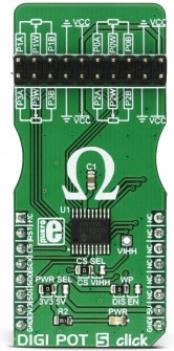
|
DIGI POT 5 click Released

DIGI POT 5 click is a digitally controlled quad potentiometer, with the resistance of 10K?. It has an 8bit wiper step resolution, which allows the wiper to take 257 different discrete positions (across 256 internal resistors). The digital wiper position can be controlled via the SPI interface. DIGI POT 5 click features a durable EEPROM non-volatile (NV) memory for storing the wiper position. The content of the wiper register memory located in the NV memory is copied to the actual wiper registers after the power-on or reset state, so the device acts similar to its mechanical counterpart, recalling its last used wiper position after being powered on. The device also features the WiperLock™ technology, which effectively locks the wiper position in place.
DIGI POT 5 click has a multitude of practical uses in electronic circuits. The most popular uses include precision calibration of set point thresholds, sensor trimming, LCD contrast adjustment, audio attenuation, an adjustable gain for amplifiers and offset trimming. DIGI POT 5 click can be used to replace the common mechanical trim pot, in a wide range of different applications where the operating voltage stays within the limits. |
2018/01/19 |


|
IrDA 3 click Released

IrDA 3 click is an intelligent IR transceiver device that can both send and receive UART commands via the IR interface. IrDA 3 click features both the IR transceiver and the encoder/decoder IC, used to convert the UART data and send or receive it in IrDA® compatible format. IrDA 3 click also has an onboard clock generator for the fastest possible UART performance of 115,200 bps, so it does not need an additional clock signal to be generated by the MCU.
IrDA 3 click provides a direct and easy to use UART to IrDA interface. The device can be used for various applications that use the short-range remote communication, such as fax machines, photocopiers, screen projectors, TV boxes, Data loggers, GPS, various system controllers and many other IRDA standard compatible applications. |
2018/01/19 |

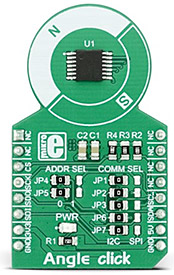
|
Angle click Released

Angle click is a precise Hall-effect angle sensing click board that can be used to measure the rotational angle of the magnetic field in the X-Y plane above it (parallel to the surface of the click), through the whole range of 360°. The click yields very precise results for both off-axis and axis operation, which make it a perfect choice for precise measuring of the rotational angle in a wide range of different high-speed applications, for example in the automotive industry: electronic power steering, transmission, torsion bar, or the motor shaft rotation.
Angle click features the A1335 Hall-effect angle sensing IC, made by Allegro MicroSystems LLC. This IC measures the magnetic field angular vector, based on the actual physical reading of the integrated Hall-effect sensor, as well as the user selected parameters, such as the digital filtering, dynamic range and scaling. The integrated 32bit MCU ensures that the processed data is delivered with a minimal delay and it has enough power to provide the complex processing of the input values so that the measurement remains fast, precise and linear.
|
2018/01/19 |

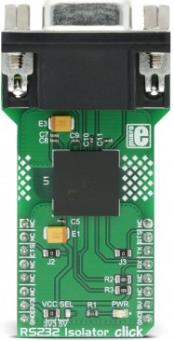
|
RS232 Isolator click Released

RS232 Isolator click is a fully isolated dual transceiver click, used to provide secure and easy UART to RS232 conversion, with the galvanic isolation. The digital input and output signals are transmitted across the isolation barrier by utilizing the Analog Devices proprietary iCoupler® technology - IC scale transformer windings couple the digital signals magnetically, from one side of the barrier to the other, providing the galvanic isolation and transfer rates up to 460Kbps.
RS232 Isolator click can be used for galvanic isolation of RS232 signals, whenever there is a need for that kind of isolation - operating in harsh environments where electrostatic discharges (ESD) can occur, when the RS232 cable is plugged in and out frequently, and generally - wherever the sensitive part of the RS232 controller logic circuitry needs to be protected. |
2018/01/19 |


|
ECG/EMS/GSR Cable Released

ECG/EMS/GSR cable is a durable 1.5 m long insulated copper cable, with a small 3.5 mm jack on one end and the electrode holders on the other end. The cable is used to securely connect the electrodes to the appropriate click board™. The two electrode holders consist of a metal piece that has a dent in the middle, that perfectly fits the rivets on the electrodes. The contact with the measurement click board™ remains good and secure while mounting the electrodes on the cable is simple and easy.
Note: The cable without probes is not meant to be used as such, the cable is used to connect the appropriate electrodes, depending on the required type: it can be used with either ECG, EMS or GSR type of probes.
|
2018/01/19 |

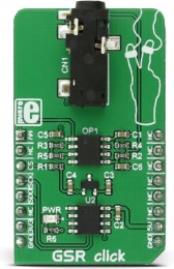
|
GSR click Released

GSR click can be used to measure the electrodermal activity (EDA) of the human body, also known as the galvanic skin response (GSR). EDA is actually the property of the human body that causes continuous variation in the electrical characteristics of the skin. EDA monitoring is usually combined with the monitoring of the heart rate, respiratory rate, and blood pressure, giving a complete insight into some of the parameters of the autonomous nervous systems of the human body.
EDA measurement is a component of modern polygraph devices, often used as lie detectors. Recent research reveals that there is more to EDA than it seems, so the studies continue in that direction. GSR click is ideally suited to be used as the research and experimenting tool, as well as for building useful test applications based on the EDA response - such as the polygraphs. |
2018/01/19 |

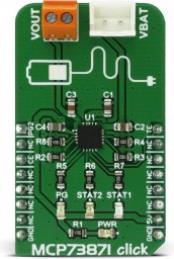
|
MCP73871 click Released

MCP73871 click is a fully integrated solution for system power delivery and Li-Po/Li-Ion battery charge management. The click features many Li-Po/Li-Ion battery charging optimizations, used to maximize the battery life. Some of the MCP73871 click features include constant current and voltage charging algorithms, overvoltage protection, automatic end of charge control, automatic recharge feature, preconditioning for depleted cells and thermal management.
All these features, coupled with the ability to simultaneously power up the system load and charge the connected battery, make this click a perfect solution for powering up many different battery-operated builds and projects, which use a rechargeable Li-Po/Li-Ion battery, but can also switch to an external power source. |
2018/01/19 |

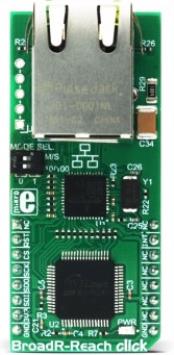
|
BroadR-Reach click Released

BroadR-Reach click brings the industry grade communication standard to the mikroBUS™, which is built to be used in an Ethernet-based open network. The click board is equipped with the BCM54811 Transceiver from Broadcom Limited, which is used to provide the hardware PHY layer for the network, and the W3150A+ from WizNet, a hardware LSI protocol stack, that provides an easy and low-cost solution for high-speed Internet connectivity for digital devices by allowing simple installation of TCP/IP stack in the hardware.
BroadR-Reach® point-to-point Ethernet PHY technology was developed by Broadcom Limited. BroadR-Reach® technology is a robust Ethernet physical layer interface, designed for use in noisy environments and harsh conditions, such as in industrial networking applications. This technology allows multiple systems to simultaneously access information over the unshielded single twisted pair cable, reducing connectivity costs and cabling weight. As such, it offers a great alternative to older, rather limited standards used so far, and enables faster data rates to be transferred over the existing cable networks. |
2017/12/20 |

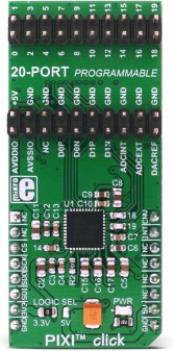
|
PIXI click Released

PIXI™ click is equipped with MAX11300 IC from Maxim Integrated, which features Maxim Integrated's versatile, proprietary PIXI™ technology - it is the industry's first configurable 20-channel mixed-signal data converter. Besides the 12bit multichannel SAR ADC and buffered DAC, it also features one internal and two external temperature sensors for tracking the junction and the environmental temperatures. Adjacent pairs of ports can be configured as logic-level translators for open-drain devices or analog switches. Each port is individually configurable with up to four selectable voltage ranges within -10 V to +10 V.
PIXI™ ports provide highly flexible hardware configuration for 12-bit mixed-signal applications. The MAX11300 is best suited for applications that demand a mixture of several analog and digital functions, such as monitoring and adjusting the bias on the power amplifiers, digital level shifters, automatic fan speed controllers, etc. Actually, it can easily adapt to specific application requirements, allowing for an easy reconfiguration, which makes it usable in virtually any embedded application. |
2017/12/20 |

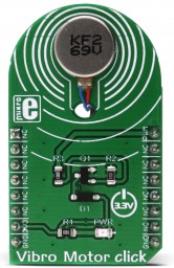
|
Vibro Motor click Released

Vibro Motor click features a compact size Eccentric Rotating Mass (ERM) motor, labeled as C1026B002F. This type of motor is often used for haptic feedback on many small handheld devices, such as the cellphones, pagers, RFID scanners and similar devices. This motor contains a small eccentric weight on its rotor, so while rotating it also produces vibration effect. This kind of motors is sometimes referred to as coin motors, due to its shape.
Besides the vibration motor, the click is also equipped with the DMG3420U, a small MOSFET, which is used to drive the motor. The Vibro Motor click is an ideal solution for adding a simple, one pin driven haptic feedback on any design. |
2017/12/20 |

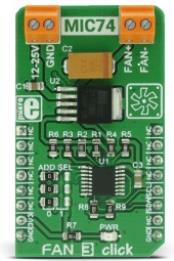
|
Fan 3 click Released

A fan is a simple device that creates a flow within some fluid - such as the air, causing the heat accumulated in one section of the fluid to be moved away from the heat source, effectively cooling the affected area. The faster the fan rotates, the faster the fluid moves. This movement causes an audible noise which is one of the most obvious reasons why the fan speed control is needed, especially when the fan is used to cool down electronic components, such as the personal computer.
Fan 3 click is the perfect choice for speed control and it can operate in seven discrete speed steps. Unlike the PWM regulation which can sometimes cause the infamous coil whining effect on some types of fans, this click board outputs the selected voltage via the MIC29152 voltage regulator from Microchip, driven through the MIC74 - a serial to parallel I/O expander and a fan controller from the same company, keeping it constant at the output. Fan 3 click works with 12V to 25V on its input connector and can be used whenever a noiseless solution with a variable fan speed is needed, for example - cooling of electronic components with the minimal possible noise produced. |
2017/12/20 |

|

